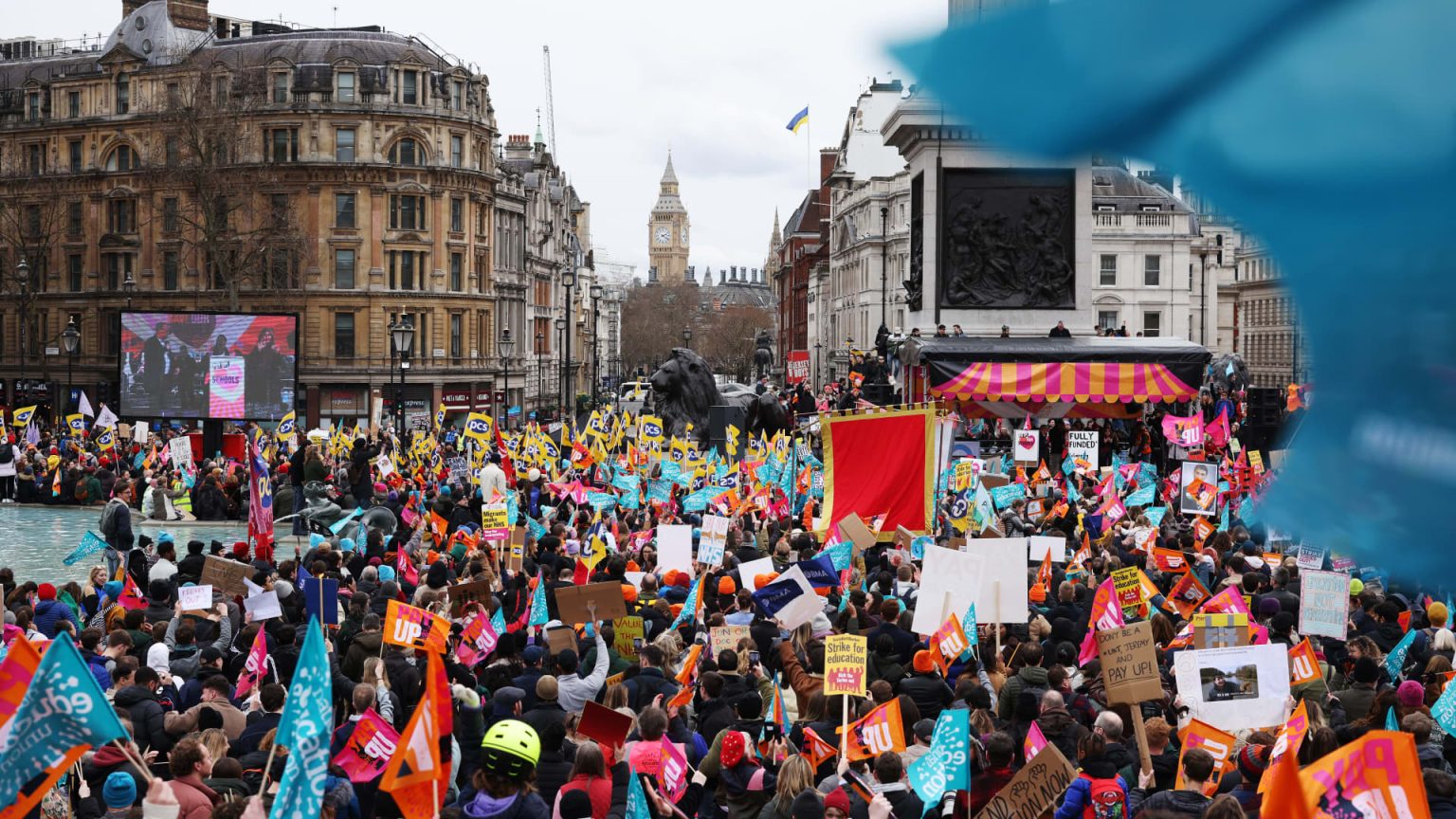LONDON — The U.K. economy flatlined in February as widespread industrial action and persistently high inflation stymied activity.
Data on Thursday showed a steady GDP in February, missing consensus expectations of 0.1% growth. Both the services and production sectors contracted, partly offset by a record 2.4% expansion in construction.
This followed an upwardly revised 0.4% expansion in GDP in January, which means output grew by 0.1% in the three months to the end of February.
Large-scale strike action has been carried out in recent months by teachers, doctors, civil servants and rail workers, among others — members of the sectors that were the largest contributors to the fall in February services output.
“There was anecdotal evidence, reported on monthly business survey returns, to suggest that industrial action in February 2023 had a notable impact on different industries of varying degrees,” the Office for National Statistics said Thursday.
“These included the health sector (nurses and the ambulance service), the civil service, the education sector (teachers and university lecturers) and the rail network.”
In response to the figures, British Finance Minister Jeremy Hunt insisted that the country’s outlook was “brighter than expected,” stressing that the U.K. is “set to avoid recession thanks to the steps we have taken,” according to multiple news outlets.
The independent Office for Budget Responsibility no longer expects the U.K. economy to enter a technical recession in 2023 — defined as two consecutive quarters of contractions. The country’s fiscal position received a substantial boost from falling gas prices.
This enabled Hunt to announce further fiscal support in his Spring Budget, which the Bank of England projects will increase GDP by around 0.3% over the coming years, although Britain’s tax burden remains at a 70-year high.
Recession fears ‘likely to stalk the UK for some time’
Economists by and large do not share Hunt’s bullishness, particularly as the central bank continues to aggressively hike interest rates in order to rein in persistently sky-high inflation, which unexpectedly jumped to an annual 10.4% in February.
Suren Thiru, economics director at ICAEW, said the Thursday GDP figures “suggest that the economy has lost momentum as sky-high inflation and strike action continue to drag on key drivers of U.K. GDP, notably services and industrial production.”
“Recession fears are likely to stalk the U.K. for some time as the boost to incomes from easing inflation and lower energy bills is substantially offset by rising taxes and the lagged impact of hiking interest rates,” Thiru added.
Charles Hepworth, investment director at GAM Investments, said that Hunt’s contention that the economic outlook is looking brighter is “quite some suspension of disbelief,” given the circumstances.
“Industrial strike action was the primary root cause of stagnating growth in the U.K. over the month. March saw continued striking and April sees no decrease, therefore we are likely to continue to see the depressive effect on any growth,” Hepworth said.
PwC Senior Economist Barret Kupelian noted that the prevalence of strikes in large sub-sectors of the economy means that the U.K. is “likely to see a stop-start picture in the future as well,” consistent with the month-on-month fluctuations in output.
“The big picture story is that today’s release, combined with the revisions to economic activity, takes the three month growth rate to around 0.1%,” Kupelian said. “The economy continues to stagnate, with economic activity struggling to grow beyond pre-pandemic levels.”
The U.K. has now recovered to its pre-Covid levels of output, the ONS confirmed, making it the last major economy to do so. Economists have cited several unique factors as driving this sluggishness, such as Brexit-related loss of trade and high levels of economic activity due to the prevalence of long-term illness.
Much of the population also remains mired in a cost-of-living crisis, as inflation continues to vastly outpace wage growth, exacerbating the threat of further industrial action.
“With real incomes still continuing to fall, households facing significantly higher tax bills this year and interest rates looking set to rise further, it is hard to see where any meaningful recovery in growth is going to come from, and the stagnant picture painted in today’s numbers very much looks as if it will be the norm for the foreseeable future,” said Stuart Cole, chief macro economist at Equiti.
Bottom of the G-20 table
In its World Economic Outlook published Tuesday, the International Monetary Fund projected the U.K. GDP will shrink by 0.3% in 2023, making it the worst performer in a G-20 (Group of Twenty) that includes war-waging Russia.
The British economy is expected to fall short of Hunt’s two major fiscal rules – a falling public debt burden and a borrowing rate below 3% of GDP over the next five years.
The IMF offered a rosier medium-term outlook than its own previous estimates and is now predicting annual GDP growth of 1% in 2024, rising to 1.5% by 2028 — though this remains well below the OBR forecast that underwrote Hunt’s Budget commitments.
The IMF predicts that the budget deficit will reach 3.7% of GDP by 2028, compared to the mere 1.7% projected by the OBR.
Responding to Tuesday’s IMF projections, Hunt highlighted that the U.K.’s growth forecasts had “been upgraded by more than any other G-7 country.”
“The IMF now say we are on the right track for economic growth. By sticking to the plan we will more than halve inflation this year, easing the pressure on everyone,” he added.
Read the full article here




